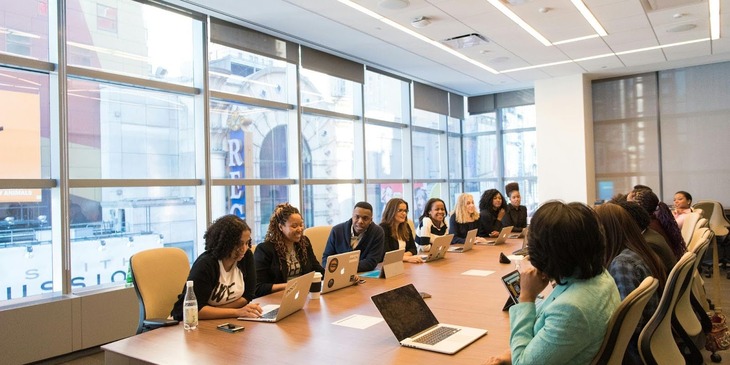
In the ever-evolving landscape of corporate interactions, the emergence of hybrid meetings represents a transformative approach to collaboration, seamlessly blending physical and virtual elements within conference room environments. Organizations are charting new territories in communication dynamics and productivity by harmonizing traditional face-to-face engagement with remote participation. The strategic deployment of technology has revolutionized team interactions, offering a glimpse into a future where the boundaries between physical and virtual realms converge.
What is a Hybrid Meeting?
Hybrid meetings embody the fusion of in-person presence and remote participation, facilitating fluid collaboration among individuals in diverse physical locations. While these meetings offer flexibility and inclusivity, they present technological challenges that necessitate effective communication strategies and engagement tactics for successful outcomes. Leveraging tools like video conferencing platforms and interactive whiteboards can amplify participant interaction and overall engagement levels.
Furthermore, establishing clear meeting agendas, fostering active involvement from all attendees, and fostering avenues for virtual networking serve to bridge the gap between in-person and remote participants. Hybrid meetings can optimize teamwork and productivity irrespective of geographical boundaries by conscientiously addressing these facets.
Combined Space: Connecting Face-to-Face teams with Remote Employees
In the contemporary workplace milieu, amalgamating face-to-face teams with remote employees within a shared space has become imperative for fostering seamless collaboration and maximizing productivity. Pioneering a hybrid workspace that accommodates physical and virtual presences is pivotal in ensuring effective team integration and employing communication strategies catering to remote participation, such as harnessing video conferencing tools and dedicated collaboration platforms, bolsters virtual collaboration.
Organizations foster inclusivity and cohesion by bridging the chasm between in-person and remote team members. This unified space fosters real-time interactions, facilitates information dissemination, and heightens overall engagement levels. Harnessing technology and nurturing a culture of inclusiveness are cornerstone elements in establishing a thriving hybrid meeting environment.
How Do You Run an Inclusive Hybrid Meeting?
Conducting an inclusive hybrid meeting necessitates meticulous planning and strategic execution to ensure all in-person or remote participants feel equally engaged and valued in the collaborative endeavor. Embracing inclusivity strategies is paramount, including provisions for remote participation through video conferencing and interactive tools.
Engagement methodologies such as active listening, encouraging contributions from all attendees, and nurturing a respectful ambiance are imperative. Effective communication entails delineating clear meeting agendas, employing inclusive language, and allowing every individual to voice their thoughts.
 Top Conference Room Technology for Hybrid Meetings
Top Conference Room Technology for Hybrid Meetings
The selection of conference room technology is critical in orchestrating successful hybrid meetings, ensuring seamless collaboration between in-person and remote participants. Key considerations encompass the deployment of a dependable Conference Room Scheduler for streamlined room booking, state-of-the-art Video Conferencing Systems for immersive virtual interactions, cutting-edge Display Technology for crystal-clear presentations, meticulous Room Layout and Design for optimal engagement, and effective Collaboration Solutions to facilitate productive discussions.
Conference Room Scheduler
Revolutionizing collaboration in contemporary workplaces, the Conference Room Scheduler technology streamlines meeting efficiency by simplifying the scheduling process through advanced scheduling software. It facilitates seamless remote integration, enabling team members to book and manage conference rooms from any location. The Conference Room Scheduler optimizes room utilization by furnishing real-time availability information, curbing conflicts, and maximizing space utilization.
Video Conferencing Systems
Deploying cutting-edge video conferencing systems is paramount for optimizing hybrid meeting experiences in contemporary workplaces. These systems facilitate remote participation, ensuring that all team members, whether on-site or remote, can actively partake in discussions. Virtual integration features facilitate seamless communication between on-site and remote participants, fostering enhanced collaboration. By offering hybrid solutions, video conferencing systems facilitate a seamless transition between physical and virtual meetings, accommodating diverse work setups.
Display Technology
Cutting-edge display technology is critical in optimizing hybrid meeting experiences in modern workplaces. Interactive displays are indispensable for engaging participants both in-person and remotely, fostering collaboration. Digital signage software can convey real-time information, agenda items, and updates, ensuring all attendees remain informed. These displays also serve as practical communication tools, enabling seamless integration with remote collaboration platforms for virtual meetings. Incorporating advanced display technology enhances the overall meeting experience, facilitating dynamic interactions and elevating engagement levels among all participants.
Room Layout and Design
Room layout and design greatly influence hybrid meeting experiences by crafting an environment conducive to seamless collaboration among in-person and remote participants. Technology integration is paramount to ensure both physical and virtual attendees can interact seamlessly. Furniture arrangements should cater to camera angles and visibility for all participants. Lighting choices must be discerning to mitigate glare and ensure all participants are clearly visible. Sound considerations, such as utilizing quality microphones and speakers, are critical for maintaining clear communication. Lastly, fostering a sense of virtual presence through room design and layout can engender greater engagement and connectivity among remote participants.

Collaboration Solutions
Elevating hybrid meeting experiences necessitates integrating advanced collaboration solutions that seamlessly unite in-person and remote participants. Virtual collaboration tools are pivotal in bridging the gap between on-site and remote teams, facilitating effective communication strategies. These solutions empower real-time interactions, ensuring a seamless flow of meeting dynamics regardless of physical location. With seamless remote connections, meeting participants can engage, contribute, and collaborate as if they were all in the same room. The crux of successful hybrid meetings lies in the seamless amalgamation of technology supporting both in-person and virtual attendees, enhancing overall meeting efficacy through superior technology integration.
Connectivity Solutions
How can top conference room technology enhance hybrid meetings in modern offices for seamless connectivity and collaboration between in-person and remote participants? Connectivity solutions play a pivotal role in ensuring smooth remote integration and virtual collaboration in a hybrid setup. Technology solutions that facilitate seamless integration between in-person conference room participants and remote attendees are vital for surmounting connectivity challenges. By furnishing reliable connectivity solutions, conference rooms can effectively facilitate remote engagement, engendering an environment conducive to participant interaction and contribution. Implementing the proper connectivity solutions in conference rooms is indispensable for optimizing the overall meeting experience and ensuring productive interactions between on-site and remote participants.
A Final Thought on the Future of Meetings
In light of the evolving landscape of workplace dynamics and technological advancements, the adoption of top conference room technology for hybrid meetings underscores the imperative for seamless integration and enhanced collaboration in modern professional settings. Future meeting trends emphasize the necessity for virtual interactions and remote engagement, necessitating advanced collaboration tools to facilitate effective communication in hybrid workspaces.





